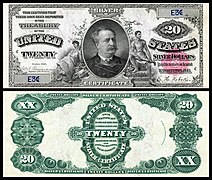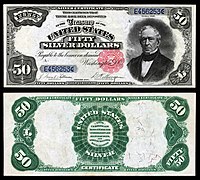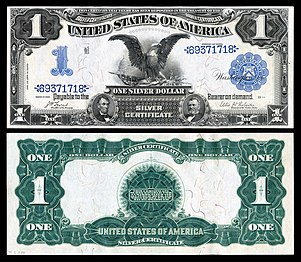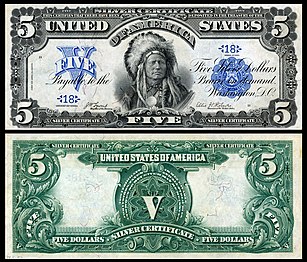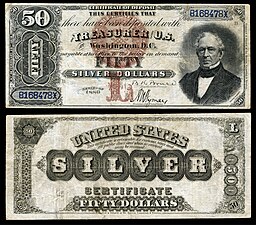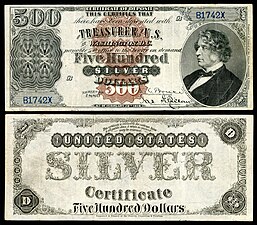Talk:Silver certificate (United States)
| Silver certificate (United States) is a featured list, which means it has been identified as one of the best lists produced by the Wikipedia community. If you can update or improve it, please do so. | ||||||||||
| This article appeared on Wikipedia's Main Page as Today's featured list on July 20, 2015. | ||||||||||
| ||||||||||
| This article is rated FL-class on Wikipedia's content assessment scale. It is of interest to the following WikiProjects: | ||||||||||||||||||||||||||||||||||||||||||||
| ||||||||||||||||||||||||||||||||||||||||||||
Silver Certificates, not FRNs!
[edit]I appreciate the enthusiasm of 129.137.181.252, but this article about Silver Certificates only! The Federal Reserve Notes are endorsed by the U.S. Government, otherwise there wouldn't be a department devoted to printing them. The section you added is more appropriate for the Federal Reserve Note article because your addition doesn't deal with Silver Certificates. Even if Federal Reserve Notes can be backed by silver in the future, they are still FRNs.
"Silver Certificates were abolished by Congress on June 4, 1963 and all redemption in silver ceased on June 24, 1968. Thus, the United States no longer has a paper currency that is legal tender for the purchase of goods & services, as any vendor may refuse to accept Federal Reserve Notes as officially stated at: http://www.treasury.gov/education/faq/currency/legal-tender.html#q1 However, the Federal Reserve Act has a poison pill provision which requires all said Notes to be redeemed in silver if Congress ever decides to abolish it. At such time a $1 Note should have the market value of one ounce of silver. In the meantime, the market has discounted such a possibility by valuing a $1 Note to be the amount of silver that it will buy as the inverse of the current spot price per ounce."
By the way, could someone please post a link to the "poison pill" clause of the Federal Reserve Act of 1913?
If no one replies to this post by December 31, 2005, this section will be deleted. If you are the author of the questioned section, please write on this page your reasoning behind the addition.
-rcnj Numismatic Article Writer
Edited To Add (10-20-2005): It already appears someone has taken the initiative in removing this material.
Poison pill clause
[edit]In addition to the lack of citation, this paragraph makes assertions unlikely on their face. Since a silver dollar was not one ounce fine at the time of passage of the Act, I cannot believe that redemption ounce-for-dollar would be provided for. This whole section looks OR and doubtful. Robert A.West (Talk) 20:18, 26 November 2006 (UTC)
- The US mint quotes the Law of 1792 as defining a dollar as "three hundred and seventy-one grains and four sixteenth parts of a grain of pure, or four hundred and sixteen grains of standard silver". An ounce
TroyAvoirdupois is 437.5 grains, and therefore this may be either a rounding by the source, or a 5% premium, which is not prohibitive.
- I note with some amusement that the Eagle is defined as "EAGLES--each to be of the value of ten dollars or units, and to contain two hundred and forty-seven grains and four eighths of a grain of pure, or two hundred and seventy grains of standard gold." This is 15.4:1.
- Crime of 1873 does not belong in the intro under that name; even in scare quotes, that's not neutral phrasing. Septentrionalis 20:59, 27 November 2006 (UTC)
- But the 1792 act was not in force when the Fed was established. The Morgan and Peace dollars were the current circulating dollars at the time, at 338.38 grains fine, which is considerably less than an ounce. Robert A.West (Talk) 08:01, 28 November 2006 (UTC)
- Source? This site says 412.5 grains of .900 silver, which would be 371.25 grains fine. But I have made (and now correct) a far more serious error, which leads me to agree in doubting this; the odds that any currency act would involved avoirdupois ounces of silver is wanishingly small. Septentrionalis 18:13, 28 November 2006 (UTC)
- But the 1792 act was not in force when the Fed was established. The Morgan and Peace dollars were the current circulating dollars at the time, at 338.38 grains fine, which is considerably less than an ounce. Robert A.West (Talk) 08:01, 28 November 2006 (UTC)
I've removed it again: with tags, it was
- However, the Federal Reserve Act has a poison pill provision which requires all said Notes to be redeemed in silver if Congress ever decides to abolish it (subject to Congress amending that provision).[citation needed] At such time a $1 note should have the market value of one ounce of silver.[dubious – discuss] In the meantime, the market has discounted such a possibility by valuing a $1 note to be the amount of silver that it will buy as the inverse of the current spot price per ounce.[original research?]
Sources for any of this are welcome. Septentrionalis 00:15, 30 November 2006 (UTC)
Clarify: Payment of a debt versus purchase of goods and services
[edit]Various unsourced edits have been reverted, including edits that resulted in the following erroneous passage:
- Thus, U.S. Federal Reserve Notes are not a paper currency that is legal tender for the purchase of goods and services, as any vendor may refuse to accept them, according to the U.S. Treasury.[1] Thus, U.S. Federal Reserve Notes are not legally backed by the goods and services of the U.S. economy.
Some of these statements are true and some are false; overall, the material does not follow logically from the material provided.
The statement that "U.S. Federal Reserve Notes are not legally backed by the goods and services of the U.S. economy," whether correct or not, has little to do with whether the Notes are a paper currency that is "legal tender for the purchase of goods and services." Likewise, the fact that a vendor may refuse to accept the Notes for the purchase of goods and services does not mean that the Notes are not legal tender for payment of debts.
The phrase "paper currency that is legal tender" relates to satisfaction (payment) of debts (pre-existing obligations), not purchase of goods and services (which instead involve contemporaneous exchanges). Yes, any vendor may refuse to accept cash in payment of goods and services, as documented in the link to the Treasury department web site. A payment of goods and services in this context means a contemporaneous exchange, such as buying a hamburger at McDonald's. This is not a "payment of a debt" for purposes of the term "legal tender."
By contrast, if you owe McDonald's ten thousand dollars for a bunch of hamburgers you bought at McDonald's "on credit" a long time ago, then a tender of Federal Reserve notes in payment of that pre-existing debt would be a legal tender, and McDonald's would probably have no realistic choice but to accept the cash.
In short, the "source" provided -- the Treasury web site -- is not really a valid source for the claim that was being made in the article. Yours, Famspear 23:51, 14 January 2007 (UTC)
Explain William Windom and "$2 silver certificate"
[edit]
Will somebody please explain this image, and the claims about it at William Windom. There is absolutely nothing about it in this article. Is this just a hoax somebody has foisted upon us? Gene Nygaard (talk) 17:59, 21 November 2007 (UTC)
If JFK signed EO 11110 for the US Treasury Dept. to print $4.29 Billion in Silver Certificates on June 4, 1963($2 and $5 notes), how can it also be abolished on the same date by congress? http://wiki.riteme.site/wiki/Executive_Order_11110 —Preceding unsigned comment added by 68.236.164.192 (talk) 19:23, 13 May 2009 (UTC)
1935A blue seal W.A. Julian - Henry Morgenthau, Jr.
[edit]interested in finding the value of the $1 silver certificate 1935 a series with a blue seal circulated —Preceding unsigned comment added by 67.149.176.226 (talk) 15:36, 10 August 2010 (UTC)
- How much value is the dollar bill 2600:1012:B109:43F6:FD2D:5EEF:3612:6F85 (talk) 02:47, 12 July 2023 (UTC)
Star Notes
[edit]Why does the explanation given in this article for the "star note" differ entirely from the information given in the Star Note article? -- lowgenius -- My Talk Page 04:17, 9 November 2011 (UTC)
I'm guessing it's because the person who edited it doesn't really know what a star note signifies. I'm just going to take that sentence out. It doesn't really add anything to the article, and as the article changes, it's no longer going to "line up" with the image, anyway. Almostfm (talk) 14:47, 15 December 2011 (UTC)
Kennedy and EO 11110
[edit]Unless someone's got a good reason not to, I'm going to tweak the sentence about 11110 "authorizing the Treasury" to issue new silver certs. That's really not what it did--11110 just delegated the existing authority from the President to the Treasury Secretary. My hunch is that the intent of including the sentence was to imply that this was some new authority, which is wasn't. Almostfm (talk) 10:59, 21 April 2012 (UTC)
OK--after a year and a half (I forgot to make the change I suggested), I've modified the section.Almostfm (talk) 07:19, 18 September 2013 (UTC)
Image substitution
[edit]I substituted two higher resolution images for existing images. Please let me know if this is a problem. Thanks--Godot13 (talk) 06:50, 3 March 2013 (UTC)
Conversion to list?
[edit]I wondered if there would be any objection to converting this article into a list-class article (with the express intent of nominating it for FLC) that would feature a table with a complete type set of large (minus two notes represented by BEP proofs) and small size silver certificates (all 800dpi).-Godot13 (talk) 19:05, 21 December 2013 (UTC)
- Just double-checking to make sure there's no objection/discussion needed before I start working offline to develop this.-Godot13 (talk) 05:59, 20 January 2014 (UTC)
Conversion underway - lead restructured, some re-written, refs added. Tables with typeset added. Working on last sections (small size and end of certs).--Godot13 (talk) 23:04, 14 February 2014 (UTC)
- Conversion complete. Just tweaking now.-Godot13 (talk) 01:33, 18 February 2014 (UTC)
Title change
[edit]If there is no objection, I am going to change the title of the article to "Silver Certificate (United States)". Both the Republic of Hawaii and the Philippines issued a silver certificate and future articles may need the disambiguation.-Godot13 (talk) 04:54, 18 February 2014 (UTC)
- I have moved the article back to Silver certificate because there is no need to disambiguate the article until other articles with the same title are created; such articles might never be created. If such articles are created, I have no objections to the article title being disambiguated again, but the "C" in "certificate" should be lowercase, to be consistent with the usage in the article text. Neelix (talk) 16:39, 11 October 2014 (UTC)
- Neelix- These are the kinds of things that should be discussed on a talk page prior to execution. Doing so would have revealed that Silver certificate (Cuba) is nearly ready to be moved to article space. Could you please undo the move you have just done? Thanks.--Godot13 (talk) 17:59, 11 October 2014 (UTC)
- I would certainly be glad to do so once the Cuba article goes live. Thank you for letting me know about it. Neelix (talk) 18:02, 11 October 2014 (UTC)
- Neelix - the article is live at Silver certificate (Cuba).--Godot13 (talk) 04:01, 12 October 2014 (UTC)
- I would certainly be glad to do so once the Cuba article goes live. Thank you for letting me know about it. Neelix (talk) 18:02, 11 October 2014 (UTC)
Small-size silver certificates
[edit]I'm not completely happy with part of this section, but I'm not quite sure how to word it.
The section "In some cases printing plates were used until they wore out, even though newer ones were also producing notes, so the sequencing of signatures may not always be chronological. Thus some of the 1935 dated dollar bills were released as late as 1963" is not technically accurate. The Series 1957 notes were the first to be printed on presses that could handle 32-subject plates. However, there weren't enough of the presses in place to handle $1 bill production, so they continued to use some of the 18 subject presses for the Series 1935 notes. By the time the Series 1963 notes were printed, there were enough to handle $1 production. The 18 subject presses continued to be used for higher denominations until the last one was replaced in 1968, so there were Series 1950 bills of $5-$100 in production along with Series 1963 bills on the new pressesAlmostfm (talk) 03:29, 15 May 2014 (UTC)
- Later addition to the list. If you would like to rework that part, you are more than welcome. I'm happy to help. Thanks--Godot13 (talk) 03:40, 15 May 2014 (UTC)
- OK, howzabout something like this: In 1957, the BEP began to install new presses capable of printing 32 notes on a sheet, and these were used to produce Series 1957 notes. Because there weren't enough of the new presses for production of all $1 silver certificates, the older 18 subject presses continued to be used until 1963 to print Series 1935 bills.Almostfm (talk) 04:17, 15 May 2014 (UTC)
- Sounds good. I may tweak it (just a little) after it goes in. Do you have a reference source to cite? If not, give me a few days and I'll find one...-Godot13 (talk) 05:03, 15 May 2014 (UTC)
- OK, howzabout something like this: In 1957, the BEP began to install new presses capable of printing 32 notes on a sheet, and these were used to produce Series 1957 notes. Because there weren't enough of the new presses for production of all $1 silver certificates, the older 18 subject presses continued to be used until 1963 to print Series 1935 bills.Almostfm (talk) 04:17, 15 May 2014 (UTC)
- Later addition to the list. If you would like to rework that part, you are more than welcome. I'm happy to help. Thanks--Godot13 (talk) 03:40, 15 May 2014 (UTC)
Courtesan Note
[edit]I've just come across a newly created article about one Helen Josephine Mansfield, which says (with a reference) that the 1891 U.S. $1,000 silver certificate, known as the Courtesan Note, depicts the image of a woman that was based on a photograph of her. However, this is not mentioned in this article. I don't feel comfortable fixing it myself, as I know almost nothing about either coinage or Ms. Mansfield. While trying to find more information about this, I came across this article on Wikicoins, which may or may not be useful. Graham87 02:58, 12 March 2015 (UTC)
- I'll do some research on this. The 1891 $1,000 note has never (within numismatics) widely been called the Courtesan Note. It has always colloquially been referred to as the Marcy note.--Godot13 (talk) 09:48, 12 March 2015 (UTC)
External links modified
[edit]Hello fellow Wikipedians,
I have just modified one external link on Silver certificate (United States). Please take a moment to review my edit. If you have any questions, or need the bot to ignore the links, or the page altogether, please visit this simple FaQ for additional information. I made the following changes:
- Added archive https://web.archive.org/web/20140114184200/http://moneyfactory.gov/historytimeline.html to http://www.moneyfactory.gov/historytimeline.html
When you have finished reviewing my changes, you may follow the instructions on the template below to fix any issues with the URLs.
This message was posted before February 2018. After February 2018, "External links modified" talk page sections are no longer generated or monitored by InternetArchiveBot. No special action is required regarding these talk page notices, other than regular verification using the archive tool instructions below. Editors have permission to delete these "External links modified" talk page sections if they want to de-clutter talk pages, but see the RfC before doing mass systematic removals. This message is updated dynamically through the template {{source check}} (last update: 5 June 2024).
- If you have discovered URLs which were erroneously considered dead by the bot, you can report them with this tool.
- If you found an error with any archives or the URLs themselves, you can fix them with this tool.
Cheers.—InternetArchiveBot (Report bug) 09:12, 12 May 2017 (UTC)
External links modified
[edit]Hello fellow Wikipedians,
I have just modified one external link on Silver certificate (United States). Please take a moment to review my edit. If you have any questions, or need the bot to ignore the links, or the page altogether, please visit this simple FaQ for additional information. I made the following changes:
- Added archive https://web.archive.org/web/20140403223347/http://moneyfactory.gov/silvercertificates.html to http://www.moneyfactory.gov/silvercertificates.html
When you have finished reviewing my changes, you may follow the instructions on the template below to fix any issues with the URLs.
This message was posted before February 2018. After February 2018, "External links modified" talk page sections are no longer generated or monitored by InternetArchiveBot. No special action is required regarding these talk page notices, other than regular verification using the archive tool instructions below. Editors have permission to delete these "External links modified" talk page sections if they want to de-clutter talk pages, but see the RfC before doing mass systematic removals. This message is updated dynamically through the template {{source check}} (last update: 5 June 2024).
- If you have discovered URLs which were erroneously considered dead by the bot, you can report them with this tool.
- If you found an error with any archives or the URLs themselves, you can fix them with this tool.
Cheers.—InternetArchiveBot (Report bug) 09:38, 24 September 2017 (UTC)
File:US-$1-SC-1891-Fr.223.jpg scheduled for POTD
[edit]Hello! This is to let editors know that the featured picture File:US-$1-SC-1891-Fr.223.jpg, which is used in this article, has been selected as the English Wikipedia's picture of the day (POTD) for September 28, 2020. A preview of the POTD is displayed below and can be edited at Template:POTD/2020-09-28. Any potential improvements or maintenance that could benefit the quality of this article should be made before its scheduled appearance on the Main Page. Other denominations will also be featured. If you have any concerns, please place a message at Wikipedia talk:Picture of the day. Thank you! Cwmhiraeth (talk) 10:39, 13 September 2020 (UTC)

|
Silver certificates are a type of representative money issued between 1878 and 1964 in the United States as part of its circulation of paper currency. This $1 silver certificate, part of the series of 1886, depicts Martha Washington; the wife of the first president is the only woman (other than vignettes representing Liberty and Justice) depicted on United States banknotes from the federal issuing period (1861 to the present). The series is known for the ornate engraving on the reverse of the notes. This banknote is part of the National Numismatic Collection at the Smithsonian Institution. Banknote design credit: Bureau of Engraving and Printing; photographed by Andrew Shiva
Recently featured:
|

|
Silver certificates are a type of representative money issued between 1878 and 1964 in the United States as part of its circulation of paper currency. This $2 silver certificate, part of the series of 1886, depicts Winfield Scott Hancock, a United States Army officer and the Democratic nominee for president in 1880. The series is known for the ornate engraving on the reverse of the notes. This banknote is part of the National Numismatic Collection at the Smithsonian Institution. Banknote design credit: Bureau of Engraving and Printing; photographed by Andrew Shiva
Recently featured:
|

|
Silver certificates are a type of representative money issued between 1878 and 1964 in the United States as part of its circulation of paper currency. This $5 silver certificate, part of the series of 1886, depicts Ulysses S. Grant, an American soldier and politician who served as the 18th president of the United States from 1869 to 1877. The series is known for the ornate engraving on the reverse of the notes. This banknote is part of the National Numismatic Collection at the Smithsonian Institution. Banknote design credit: Bureau of Engraving and Printing; photographed by Andrew Shiva
Recently featured:
|
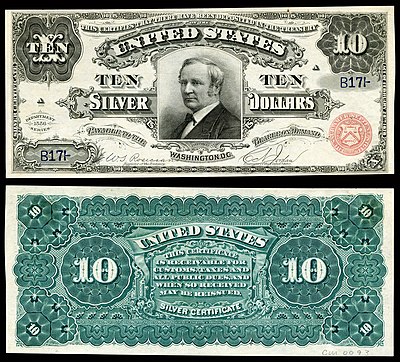
|
Silver certificates are a type of representative money issued between 1878 and 1964 in the United States as part of its circulation of paper currency. This $10 silver certificate, part of the series of 1886, depicts Thomas A. Hendricks, an American politician and lawyer from Indiana who served as the 21st vice president of the United States from March to November 1885. The series is known for the ornate engraving on the reverse of the notes. This banknote is part of the National Numismatic Collection at the Smithsonian Institution. Banknote design credit: Bureau of Engraving and Printing; photographed by Andrew Shiva
Recently featured:
|

|
Silver certificates are a type of representative money issued between 1878 and 1964 in the United States as part of its circulation of paper currency. This $20 silver certificate, part of the series of 1886, depicts Daniel Manning, an American businessman, journalist, and politician most notable for having served as the 37th secretary of the treasury. The series is known for the ornate engraving on the reverse of the notes. This banknote is part of the National Numismatic Collection at the Smithsonian Institution. Banknote design credit: Bureau of Engraving and Printing; photographed by Andrew Shiva
Recently featured:
|

|
Silver certificates are a type of representative money issued between 1878 and 1964 in the United States as part of its circulation of paper currency. This $10 silver certificate, part of the series of 1878, depicts Robert Morris, a Founding Father who served as Superintendent of Finance from 1781 to 1784. The series is known for the ornate engraving on the reverse of the notes. This banknote is part of the National Numismatic Collection at the Smithsonian Institution. Banknote design credit: Bureau of Engraving and Printing; photographed by Andrew Shiva
Recently featured:
|

|
Silver certificates are a type of representative money issued between 1878 and 1964 in the United States as part of its circulation of paper currency. This $20 silver certificate, part of the series of 1878, depicts Stephen Decatur, a United States naval officer and commodore who became a national hero after his numerous naval victories. The series is known for the ornate engraving on the reverse of the notes. This banknote is part of the National Numismatic Collection at the Smithsonian Institution. Banknote design credit: Bureau of Engraving and Printing; photographed by Andrew Shiva
Recently featured:
|

|
Silver certificates are a type of representative money issued between 1878 and 1964 in the United States as part of its circulation of paper currency. This $50 silver certificate, part of the series of 1878, depicts Edward Everett, an American politician, pastor, educator, diplomat, and orator from Massachusetts who served as Secretary of State from 1852 to 1853. The series is known for the ornate engraving on the reverse of the notes. This banknote is part of the National Numismatic Collection at the Smithsonian Institution. Credit: Bureau of Engraving and Printing; photographed by Andrew Shiva
Recently featured:
|

|
Silver certificates are a type of representative money issued between 1878 and 1964 in the United States as part of its circulation of paper currency. This $100 silver certificate, part of the series of 1878, depicts James Monroe, an American statesman, lawyer, diplomat and Founding Father who served as the fifth president of the United States from 1817 to 1825. The series is known for the ornate engraving on the reverse of the notes. This banknote is part of the National Numismatic Collection at the Smithsonian Institution. Banknote design credit: Bureau of Engraving and Printing; photographed by Andrew Shiva
Recently featured:
|

|
Silver certificates are a type of representative money issued between 1878 and 1964 in the United States as part of its circulation of paper currency. This $500 silver certificate, part of the series of 1878, depicts Charles Sumner, an American lawyer, politician and United States senator from Massachusetts. The series is known for the ornate engraving on the reverse of the notes. This banknote is part of the National Numismatic Collection at the Smithsonian Institution. Banknote design credit: Bureau of Engraving and Printing; photographed by Andrew Shiva
Recently featured:
|
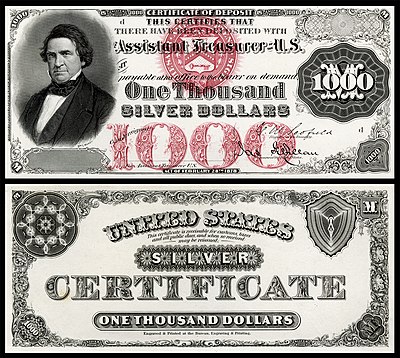
|
Silver certificates are a type of representative money issued between 1878 and 1964 in the United States as part of its circulation of paper currency. This $1000 silver certificate, part of the series of 1878, depicts William L. Marcy, an American lawyer and politician, who served as Secretary of State from 1853 to 1857. The series is known for the ornate engraving on the reverse of the notes. This banknote is part of the National Numismatic Collection at the Smithsonian Institution. Banknote design credit: Bureau of Engraving and Printing; photographed by Andrew Shiva
Recently featured:
|
Featured picture scheduled for POTD
[edit]Hello! This is to let editors know that File:US-$1-SC-1891-Fr.223.jpg and others, several featured pictures used in this article, has been selected as the English Wikipedia's picture of the day (POTD) for June 28, 2022. A preview of the POTD is displayed below and can be edited at Template:POTD/2022-06-28. For the greater benefit of readers, any potential improvements or maintenance that could benefit the quality of this article should be done before its scheduled appearance on the Main Page. If you have any concerns, please place a message at Wikipedia talk:Picture of the day. Thank you! Adam Cuerden (talk)Has about 7.8% of all FPs 15:40, 23 May 2022 (UTC)
Silver certificates are a type of representative money issued between 1878 and 1964 in the United States as part of its circulation of paper currency. They were produced in response to silver agitation by citizens who were angered by the Coinage Act of 1873, which had effectively placed the United States on a gold standard. Since 1968 they have been redeemable only in Federal Reserve Notes and are thus obsolete, but they remain legal tender at their face value and hence are still an accepted form of currency. This is a complete set of the 1891 series of large-size silver certificates, designed by the Bureau of Engraving and Printing and comprising eight denominations from $1 to $1000. Each banknote bears the signatures of James Fount Tillman (Register of the Treasury) and Daniel N. Morgan (Treasurer of the United States), and a portrait of a different individual, identified above. Banknote design credit: Bureau of Engraving and Printing; photographed by Andrew Shiva
Recently featured:
|
{{subst:Upcoming POTD|File:US-$2-SC-1899-Fr-249.jpg|2022-07-28}}
Featured picture scheduled for POTD
[edit]Hello! This is to let editors know that File:US-$2-SC-1899-Fr-249.jpg, a featured picture used in this article, has been selected as the English Wikipedia's picture of the day (POTD) for July 28, 2022. A preview of the POTD is displayed below and can be edited at Template:POTD/2022-07-28. For the greater benefit of readers, any potential improvements or maintenance that could benefit the quality of this article should be done before its scheduled appearance on the Main Page. If you have any concerns, please place a message at Wikipedia talk:Picture of the day. Thank you! Adam Cuerden (talk)Has about 7.8% of all FPs 01:17, 26 May 2022 (UTC)
Silver certificates are a type of representative money issued between 1878 and 1964 in the United States as part of its circulation of paper currency. They were produced in response to silver agitation by citizens who were angered by the Coinage Act of 1873, which had effectively placed the United States on a gold standard. Since 1968 they have been redeemable only in Federal Reserve Notes and are thus obsolete, but they remain legal tender at their face value and hence are still an accepted form of currency. This is a complete set of the 1899 series of large-size silver certificates, designed by the Bureau of Engraving and Printing and comprising three denominations from $1 to $5. Each banknote bears the engraved signatures of Judson Whitlocke Lyons (Register of the Treasury) and Ellis H. Roberts (Treasurer of the United States), and a portrait of a different individual or individuals, identified above. Banknote design credit: Bureau of Engraving and Printing; scanned by Godot13
Recently featured:
|
Featured picture scheduled for POTD
[edit]Hello! This is to let editors know that two files from this article have been selected as the English Wikipedia's picture of the day (POTD) for September 5, 2023. A preview of the POTD is displayed below and can be edited at Template:POTD/2023-09-05. For the greater benefit of readers, any potential improvements or maintenance that could benefit the quality of this article should be done before its scheduled appearance on the Main Page. If you have any concerns, please place a message at Wikipedia talk:Picture of the day. Thank you! — Amakuru (talk) 09:07, 1 September 2023 (UTC)
Silver certificates are a type of representative money issued between 1878 and 1964 in the United States as part of its circulation of paper currency. They were produced in response to silver agitation by citizens who were angered by the Coinage Act of 1873, which had effectively placed the United States on a gold standard. Since 1968 they have been redeemable only in Federal Reserve Notes and are thus obsolete, but they remain legal tender at their face value and hence are still an accepted form of currency. This is a complete set of the 1923 series of large-size silver certificates, designed by the Bureau of Engraving and Printing and comprising two denominations, one dollar and five dollars. On the obverse, each banknote bears the portrait of a U.S. president (George Washington and Abraham Lincoln) and the engraved signatures of a register of the Treasury (W. O. Woods and H. V. Speelman) and a treasurer of the United States (H. T. Tate and Frank White). Banknote design credit: Bureau of Engraving and Printing
Recently featured:
|
Featured picture scheduled for POTD
[edit]Hello! This is to let editors know that File:US-$10-SC-1880-Fr-287.jpg, a featured picture used in this article, has been selected as the English Wikipedia's picture of the day (POTD) for March 7, 2024. A preview of the POTD is displayed below and can be edited at Template:POTD/2024-03-07. For the greater benefit of readers, any potential improvements or maintenance that could benefit the quality of this article should be done before its scheduled appearance on the Main Page. If you have any concerns, please place a message at Wikipedia talk:Picture of the day. Thank you! — Amakuru (talk) 17:12, 2 March 2024 (UTC)
Silver certificates are a type of representative money issued between 1878 and 1964 in the United States as part of its circulation of paper currency. They were produced in response to silver agitation by citizens who were angered by the Coinage Act of 1873, which had effectively placed the United States on a gold standard. Since 1968 they have been redeemable only in Federal Reserve Notes and are thus obsolete, but they remain legal tender at their face value and hence are still an accepted form of currency. These are six banknotes from the 1880 series of large-size silver certificates, designed by the Bureau of Engraving and Printing and comprising eight denominations from $1 to $1000. Each banknote bears a portrait of a different individual, identified above. Banknote design credit: Bureau of Engraving and Printing; photographed by Andrew Shiva
Recently featured:
|
Featured picture scheduled for POTD
[edit]Hello! This is to let editors know that File:US-$1-SC-1934-Fr.1606.jpg, a featured picture used in this article, has been selected as the English Wikipedia's picture of the day (POTD) for October 10, 2024. A preview of the POTD is displayed below and can be edited at Template:POTD/2024-10-10. For the greater benefit of readers, any potential improvements or maintenance that could benefit the quality of this article should be done before its scheduled appearance on the Main Page. If you have any concerns, please place a message at Wikipedia talk:Picture of the day. Thank you! — Amakuru (talk) 11:07, 2 October 2024 (UTC)
|
Silver certificates are a type of representative money issued between 1878 and 1964 in the United States as part of its circulation of paper currency. They were produced in response to silver agitation by citizens who were angered by the Coinage Act of 1873, which had effectively placed the United States on a gold standard. Since 1968 they have been redeemable only in Federal Reserve Notes and are thus obsolete, but they remain legal tender at their face value and hence are still an accepted form of currency. These are three banknotes from the 1934 series of silver certificates, designed by the Bureau of Engraving and Printing and comprising the denominations $1, $5 and $10. Each banknote bears a portrait of a different individual, identified above. Banknote design credit: Bureau of Engraving and Printing
Recently featured:
|
- Featured lists that have appeared on the main page
- Featured lists that have appeared on the main page once
- FL-Class United States articles
- Low-importance United States articles
- FL-Class United States articles of Low-importance
- WikiProject United States articles
- FL-Class numismatic articles
- Mid-importance numismatic articles
- FL-Class American currency articles
- Unknown-importance American currency articles
- American currency articles
- WikiProject Numismatics articles
- FL-Class Smithsonian Institution-related articles
- Low-importance Smithsonian Institution-related articles
- WikiProject Smithsonian Institution-related articles
- FL-Class List articles
- Low-importance List articles
- WikiProject Lists articles









